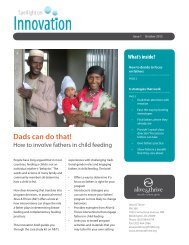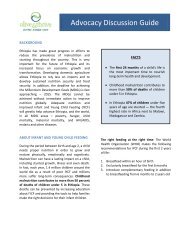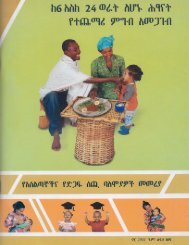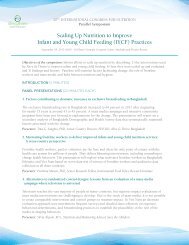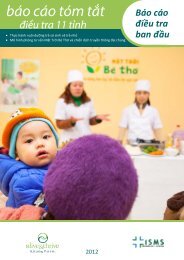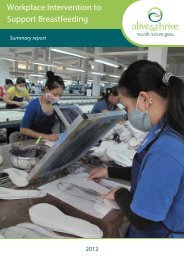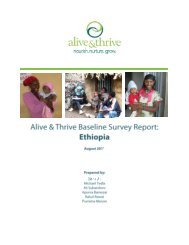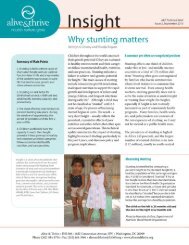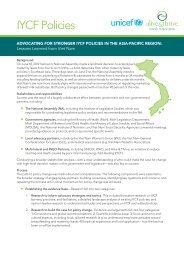IYCF Practices, Beliefs, and Influences in Tigray ... - Alive & Thrive
IYCF Practices, Beliefs, and Influences in Tigray ... - Alive & Thrive
IYCF Practices, Beliefs, and Influences in Tigray ... - Alive & Thrive
Create successful ePaper yourself
Turn your PDF publications into a flip-book with our unique Google optimized e-Paper software.
“Feed<strong>in</strong>g with a bottle <strong>in</strong> addition to breastmilk helps the child to grow strong.<br />
Besides it has the advantage of m<strong>in</strong>imiz<strong>in</strong>g wastage of the liquid.” (A mother from<br />
Hawizen)<br />
“Even if I am not do<strong>in</strong>g it [us<strong>in</strong>g bottle], it helps to protect the child from illness, to<br />
grow fast <strong>and</strong> strong. I know it is good. It will also give me a break from<br />
breastfeed<strong>in</strong>g.” (A mother from Raya Azebo)<br />
“……nowadays bottle feed<strong>in</strong>g is not good for the child. But if the mother has a<br />
problem, this may be used as a solution.” (Community leader <strong>in</strong> Tahitay Macho)<br />
Feed<strong>in</strong>g frequency <strong>and</strong> quantity of complementary foods: Overall the feed<strong>in</strong>g frequency of<br />
complementary foods across the three research communities ranges from one to five times per day. One<br />
child <strong>in</strong> Raya Azebo was reported to have eaten noth<strong>in</strong>g <strong>in</strong> the previous day, due to illness. The feed<strong>in</strong>g<br />
frequency for many of the children <strong>in</strong> the study communities was found to be below the m<strong>in</strong>imum<br />
recommendation. The recommendation is to feed a child two to three times per day from 6 to 8 months<br />
of age; three to four times per day from 9 to 11 months; <strong>and</strong> five times a day for those aged 12 to 24<br />
months, with additional snacks offered once or twice per day. The average feed<strong>in</strong>g frequencies <strong>in</strong> all<br />
communities reported for this study were one time per day for children 6 to 11 months <strong>and</strong> two times<br />
for children aged 12 months <strong>and</strong> older.<br />
Mothers described the quantity of complementary foods given us<strong>in</strong>g the size of their palm for solid<br />
foods such as <strong>in</strong>jera <strong>and</strong> unleavened bread. They also used a coffee cup to measure other foods. The<br />
amount of food given to children ranged from one-quarter palm size to eight palms for solid foods, <strong>and</strong><br />
from one-quarter of an Ethiopian coffee cup to four coffee cups for semisolid foods <strong>and</strong> liquids.<br />
Mothers expressed their will<strong>in</strong>gness to <strong>in</strong>crease feed<strong>in</strong>g frequency if told by health workers to do so.<br />
Mothers said the advice was useful to make the child grow fast <strong>and</strong> be healthy <strong>and</strong> strong. Some<br />
mothers, however, stated they would not <strong>in</strong>crease the feed<strong>in</strong>g frequency or the quantity, even if told to<br />
by health workers. Most said that they can’t afford to feed their children more. Others expressed their<br />
belief that the frequency the child is feed<strong>in</strong>g is enough for the adequate growth. Some mentioned that<br />
they believe the frequency of complementary feed<strong>in</strong>g is adequate s<strong>in</strong>ce it is given with breastmilk.<br />
Some mothers said they are will<strong>in</strong>g to <strong>in</strong>crease the quantity of food if they are advised to do so for the<br />
sake of their child’s health, strength, energy, satisfaction, <strong>and</strong> protection from diseases. A mother from<br />
Tahitay Maichew reported that she will also <strong>in</strong>crease the amount if she is advised by elders, her mother,<br />
<strong>and</strong> neighbors.<br />
“I will <strong>in</strong>crease the amount of food. If I don’t listen to their advice, they will <strong>in</strong>sult<br />
me <strong>and</strong> treat me as a bad person.” (A mother from Tahitay Maichew)<br />
“If the child is able to eat, why don’t I give him more food If he shows <strong>in</strong>terest I<br />
will <strong>in</strong>crease. But it is not always possible to do this because of economic<br />
constra<strong>in</strong>ts. His father is do<strong>in</strong>g his best to br<strong>in</strong>g food <strong>and</strong> if it is necessary I will<br />
stop eat<strong>in</strong>g <strong>and</strong> will feed my child more. Noth<strong>in</strong>g is more important than your own<br />
child.” (A mother from Tahitay Maichew)<br />
14



